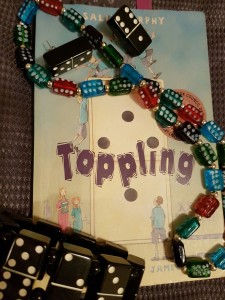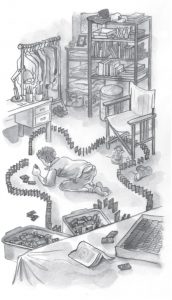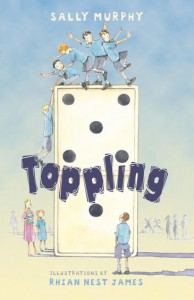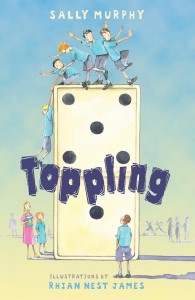Thanks again to everyone who’s been reading along with me. Today’s post is the last focusing on  Toppling – and tomorrow we move on to Roses are Blue. And that means that it will just ONE WEEK until the release of Worse Things. I am so excited about introducing my newest book-baby to the world.
Toppling – and tomorrow we move on to Roses are Blue. And that means that it will just ONE WEEK until the release of Worse Things. I am so excited about introducing my newest book-baby to the world.
For today, though, I want to share some things you can do with Toppling. These aren’t teaching notes – you’ll find more formal teaching ideas here and here. Rather than replicate those, the following ten ideas are more simple things you can do on your own, with your family, or in a classroom. So, here’s the list:
- Read it. The number one thing you can do with any book is simply read it. On your own, with a friend, at the same time as the author (as with this readalong). In bed, on a couch, out in the garden, or out loud in the classroom (teachers remember no one is ever too old to be read TO). And sometimes, just reading the book is all that’s needed – no worksheets, comprehension questions or anything.
- Journal about it. Although I’ve said in number one that comprehension questions are not always necessary, sometimes it is nice to have time to really reflect on a book – either as a whole or, after each reading session. Grab your journal – if you haven’t got one, now’s a good time. Any notebook or exercises will do – and a pen and just write about your reactions to what you’ve just read. How did it make you feel? Which bits di you like? Which bits annoyed you? What do you think will happen next?
- Vote for the best cover. As I posted about here, Toppling has had three different covers and two different tiles, in the three countries it’s been published in. After you’ve read the book, have a look at the three covers and decide which one you prefer. If your friends or classmates have read it too, you might set up a poll.
- After you’ve decided which of the published covers you like best, you might like to design a fourth cover. What do you think should be on it? You might borrow ideas from the published covers, or you might have a better idea. If you post it on Instagram or elsewhere online, send me a message and I’ll tell you what I think.
- Write a review. A book review can be long and detailed, or it can be really short. There are reviews of Toppling here at Goodreads, and also here and here to give you some ideas.
- Grab some dominoes and set up a topple of your own. It doesn’t have to be as big as this one:
Got no dominoes? Maybe you could try a book topple instead!
Or be creative. What else could you topple? Maybe don’t waste your biscuits, but this is pretty epic:
If you do set up a topple and post it anywhere online, let me know and I’ll watch and comment. – here’s one here:
- Play a game of dominoes. Although John in the book doesn’t ever play the actual dominoes game, there’s no reason you can’t. Don’t own any dominoes? You can print some out here. You can make them stronger by gluing them to some cardboard.
- Write a poem. On page 15 of Toppling John writes a poem introducing his best mate Dominic. It’s basically a list poem. On pages 18 and 19 he shares shorter poems about his other three friends. Read these to get some ideas, then write a poem introducing yourself or one of your friends.
- One of the questions I am most often asked about Toppling is what happens next. After you’ve read it, why not write a new chapter? You get to decide what happens next.
- Ask the author (that’s me!) a question. You can post it in the comments below, email me through this contact form, or ask the question on Twitter, Instagram or Facebook. I love questions – they keep me on my toes.
I’d love to hear how you go with any of these activities – or if you have better ones to suggest.
Thanks for reading along with me.
 could handle. And I spent a lot of time worrying about the ending – both for the sake of my characters and for my young readers.
could handle. And I spent a lot of time worrying about the ending – both for the sake of my characters and for my young readers. Eventually though I settled on the ending and, after rewriting and editing, off it went to Walker Books who, once more, said yes. And, a year after
Eventually though I settled on the ending and, after rewriting and editing, off it went to Walker Books who, once more, said yes. And, a year after 


